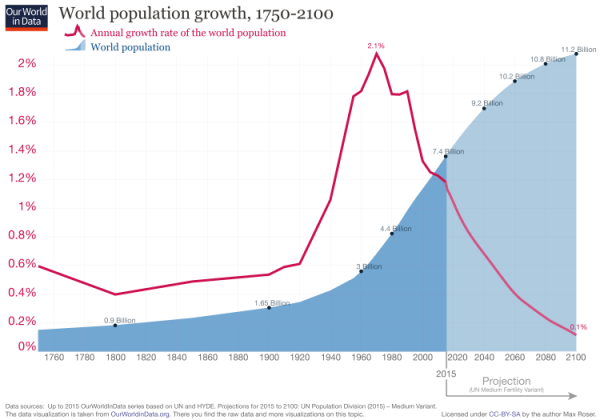Overpopulation not solved
The following substantial article covers world population growth and growth rates. It includes numerous charts that make demographic data and projections easy to understand:
by Max Roser and Esteban Ortiz-Ospina
first published in 2013; updated April, 2017
From the introduction:
200 years ago there were less than one billion humans living on earth. Today, according to UN calculations there are over 7 billion of us. Recent estimates suggest that today's population size is roughly equivalent to 6.9% of the total number of people ever born. This is the most conspicuous fact about world population growth: for thousands of years, the population grew only slowly but in recent centuries, it has jumped dramatically. Between 1900 and 2000, the increase in world population was three times greater than during the entire previous history of humanity—an increase from 1.5 to 6.1 billion in just 100 years.
How the world population is changing is of great importance for humanity’s impact on the Earth’s natural environment, but it also gives reasons to hope for a good future. This is because we have a bigger team of better educated people who can contribute to the solutions that improve global well-being.
A picture of the world population in the very long-run shows extremely rapid growth. Indeed, for a long time the world population grew at an increasing rate. However, if we focus on the last couple of decades, we see that this pattern no longer holds, as the annual rate of population growth has been recently going down. 1962 saw the growth rate peak at 2.1%, and it has since fallen to almost half. A long historical period of accelerated growth has thus come to an end.
Based on these observations, world history can be divided into three periods marked by distinct trends in population growth. The first period, pre-modernity, was a very long age of very slow population growth. The second period, beginning with the onset of modernity—which was characterized by rising standards of living and improving health—had an increasing growth rate that continued to rise through 1962. Today, the second period is over, and the third period is unfolding; the population growth rate is falling and will likely continue to fall, leading to an end of population growth towards the end of this century.
The first graph from the article shows world population growth and world population growth rate beginning in 1750 and projected to 2100:

The light blue shaded component of the graph shows a tremendous population increase from 7.4 billion in 2015 to a projected 11.2 billion in 2100. The superimposed red graph shows that while the rate of population growth is decreasing, the rate will still be positive in 2100. Thus, contrary to the article's introduction, population will continue to grow past the year 2100.
A significant problem with the article is that it focuses on Demographic Transition Theory as a causative explanation of reduced population growth, particularly in developing nations. From the article:
This is when fertility declines as a result of the social changes: Parents realise that as progress kick in the mortality of children is not as high as it once was and they therefore opt for fewer births, the economy is undergoing structural changes that makes children less economically valuable, and women are empowered socially and within partnerships. The fertility rate is declining steeply.
In other words, as undeveloped countries become industrialized, their fertility will decrease. It should be noted that a competing and contradictory theory is simply stated as: women will have more children when they anticipate a better future. Thus, as a contry industrializes, its fertility may not decrease, and in fact might increase. Population momentum would then cause population to continue to rise for a generation. See:
Population Politics
by Virginia Deane Abernethy (Author), Garrett Hardin (Foreword)
As a consequence, projections based on application of the Demographic Transition Theory may be unrealistically low.
Another serious problem with this article is that it does not include mass immigration as the primary source of population growth in developed nations - particularly in America and in European nations. This renders many of the fertility-based projections inaccurate and useless.
In America, fertility is declinimg, however, most U.S. population growth is caused by mass immigration, legal and illegal, and subsequent births to those immigrants and illegal aliens.
The world will see tremendous population growth through the rest of this century. This will result in massive environmental and societal consequences. The overpopulation problem is not solved today, and it will not be solved by 2100.
Related
Population Driven to Double by Mass Immigration
Are There No Limits? The Crisis Of Overpopulation, Mass Immigration, And Overconsumption, The Social Contract, Summer, 2018
World Population Growth Makes the Immigration-as-Rescue Project Insane, by Brenda Walker, Limits to Growth, November 4, 2018
How many humans can the Earth support? - 7.5 billion and counting, by Fred Elbel, CAIRCO, July 19, 2018
